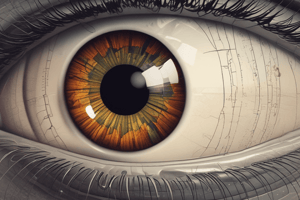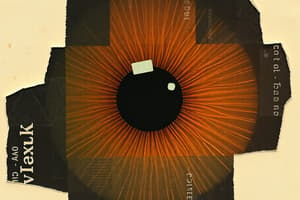Podcast
Questions and Answers
What is the primary action of the Superior Rectus muscle?
What is the primary action of the Superior Rectus muscle?
- depression
- adduction
- elevation (correct)
- intortion
What is the tertiary action of the Inferior Rectus muscle?
What is the tertiary action of the Inferior Rectus muscle?
- intortion
- elevation
- adduction (correct)
- depression
In which direction do the Superior and Inferior Rectus muscles lie in the primary position?
In which direction do the Superior and Inferior Rectus muscles lie in the primary position?
- Parallel to the visual axis
- Perpendicular to the visual axis
- At a 23-degree angle relative to the visual axis (correct)
- At a 51-degree angle relative to the visual axis
What is the primary action of the Superior Oblique muscle?
What is the primary action of the Superior Oblique muscle?
Which muscles are responsible for elevation and depression when the eye is in adduction?
Which muscles are responsible for elevation and depression when the eye is in adduction?
What is the secondary action of the Oblique muscles?
What is the secondary action of the Oblique muscles?
What happens to the Superior Rectus muscle when the eye is fully abducted?
What happens to the Superior Rectus muscle when the eye is fully abducted?
What is the tertiary action of the Superior Oblique muscle?
What is the tertiary action of the Superior Oblique muscle?
What occurs during binocular movements, like head tilt to the right?
What occurs during binocular movements, like head tilt to the right?
What is the name of the law that states that increased contraction of an agonist muscle is associated with diminished contractile activity of its antagonist muscle?
What is the name of the law that states that increased contraction of an agonist muscle is associated with diminished contractile activity of its antagonist muscle?
What is the name of the nerve that innervates the superior oblique muscle?
What is the name of the nerve that innervates the superior oblique muscle?
Which muscle is responsible for adduction and is the largest and strongest of the oculomotor muscles?
Which muscle is responsible for adduction and is the largest and strongest of the oculomotor muscles?
During convergence, which muscles experience increased activity?
During convergence, which muscles experience increased activity?
What is the vascular supply of the medial and inferior rectus muscles?
What is the vascular supply of the medial and inferior rectus muscles?
What is the result of head tilt to the right on the muscle groups?
What is the result of head tilt to the right on the muscle groups?
What is the speed range for following objects during the recording of SAFE or FESA?
What is the speed range for following objects during the recording of SAFE or FESA?
When the eye is fully adducted, which muscle is responsible for elevating the eye?
When the eye is fully adducted, which muscle is responsible for elevating the eye?
What is the angle of the plane in which the SO and IO lie relative to the primary gaze?
What is the angle of the plane in which the SO and IO lie relative to the primary gaze?
What is the purpose of the Saccades Test?
What is the purpose of the Saccades Test?
What is the purpose of the Broad H Test?
What is the purpose of the Broad H Test?
What is the distance between the two targets in the Saccades Test?
What is the distance between the two targets in the Saccades Test?
What is the direction of the circles moved during the Pursuits Test?
What is the direction of the circles moved during the Pursuits Test?
Which type of eye movement is mediated by the parieto-occipital junction (area 19)?
Which type of eye movement is mediated by the parieto-occipital junction (area 19)?
What is the term for the field in which a certain muscle has the greatest action?
What is the term for the field in which a certain muscle has the greatest action?
What is a symptom of Isolated 3rd Cranial Nerve Palsy?
What is a symptom of Isolated 3rd Cranial Nerve Palsy?
What is a sign of Isolated 3rd Cranial Nerve Palsy?
What is a sign of Isolated 3rd Cranial Nerve Palsy?
Which muscle is responsible for depressing the eye when it is fully adducted?
Which muscle is responsible for depressing the eye when it is fully adducted?
What is a possible outcome if the target is taken to the extreme limits during the SAFE or FESA test?
What is a possible outcome if the target is taken to the extreme limits during the SAFE or FESA test?
What is the term for the ability of the eyes to move together in the same direction?
What is the term for the ability of the eyes to move together in the same direction?
What is the term for fast eye movements?
What is the term for fast eye movements?
Which of the following symptoms is NOT associated with an aneurysm affecting the Posterior Communicating Artery?
Which of the following symptoms is NOT associated with an aneurysm affecting the Posterior Communicating Artery?
What is the characteristic head tilt in a patient with a 4th Cranial Nerve Palsy?
What is the characteristic head tilt in a patient with a 4th Cranial Nerve Palsy?
What is the primary reason for a patient with a 4th Cranial Nerve Palsy to experience diplopia?
What is the primary reason for a patient with a 4th Cranial Nerve Palsy to experience diplopia?
Which of the following causes of 4th Cranial Nerve Palsy has a long course through the cranial vault?
Which of the following causes of 4th Cranial Nerve Palsy has a long course through the cranial vault?
What is the characteristic change in hypertropia in a patient with a 4th Cranial Nerve Palsy?
What is the characteristic change in hypertropia in a patient with a 4th Cranial Nerve Palsy?
What is the primary reason for immediate medical evaluation in a patient with an aneurysm affecting the Posterior Communicating Artery?
What is the primary reason for immediate medical evaluation in a patient with an aneurysm affecting the Posterior Communicating Artery?
Which of the following is a common vasculopathic cause of 4th Cranial Nerve Palsy?
Which of the following is a common vasculopathic cause of 4th Cranial Nerve Palsy?
Flashcards are hidden until you start studying




